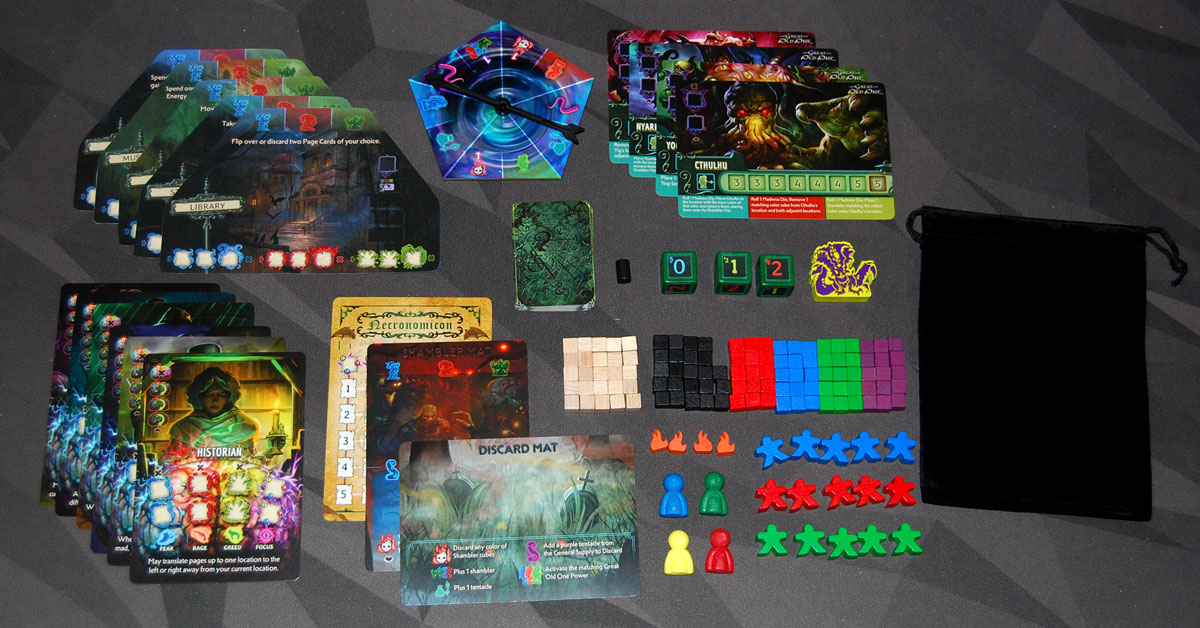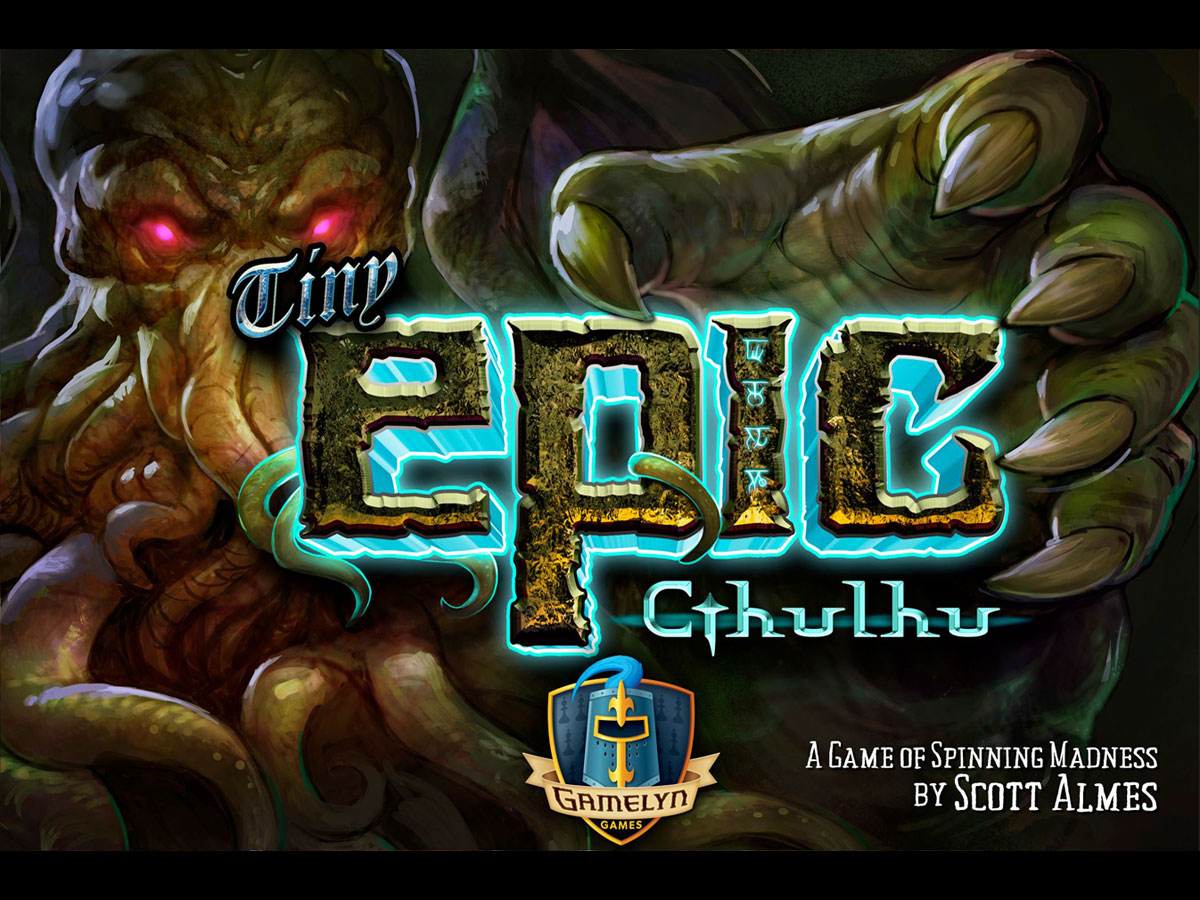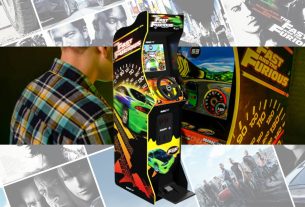The town of New Arkhamoore is overrun with shamblers as the Great Old Ones try to cross the portal from their realm to ours. Decipher the Necronomicon to learn the secrets that will allow you to seal the portals before it’s too late!
What Is Tiny Epic Cthulhu?
Tiny Epic Cthulhu is a cooperative game for 1 to 4 players, ages 14 and up, and takes about 30 to 45 minutes to play. It’s currently seeking funding on Kickstarter, with a pledge level of $25 for a copy of the base game. (There are additional tiers available, from the $20 print-and-play to the $40 deluxe bundle that includes the Cult of Chaos expansion.) Although the box says 14+, I think you could play with somewhat younger kids since it’s a cooperative game, as long as they’re okay with the Lovecraft-inspired setting.
A note about the theme: as with most games set in the world of Cthulhu, “madness” is incorporated into the game—a little madness gives you some advantages, but too much madness results in losing the game. I know there are folks who feel that isn’t an accurate or sensitive representation of mental illness, so my caveat is that Tiny Epic Cthulhu sticks pretty close to the usual script on that matter.
Tiny Epic Cthulhu was designed by Scott Almes and published by Gamelyn Games, with illustrations by Ian Rosenthaler and Susie O’Conner.
New to Kickstarter? Check out our crowdfunding primer.

Tiny Epic Cthulhu Components
Note: My review is based on a prototype copy, so it is subject to change and may not reflect final component quality. For instance, the finished spinner will look like a tentacle rather than the regular arrow spinner in the prototype, and many of the meeples are placeholder cubes rather than the custom wooden tokens that will come in the finished game.
Here’s what comes in the base game:
- 5 Town cards
- Wheel of Madness
- 4 Great Old One mats
- 30 Page cards
- Great Old One Strength token
- 3 Cthulhu dice
- 4 Great Old One meeples
- 6 Player mats
- 6 Player meeples
- Necronomicon mat
- Shambler mat
- Discard mat
- 25 Page tokens
- 23 Eldritch tentacles
- 45 Madness tentacles (15 each Fear, Rage, and Greed)
- 17 Chaos tentacles
- 4 Brain tokens
- 15 Shambler meeples (5 each Blue, Red, Green)
- Tentacle draw bag
As with the other Tiny Epic games, Tiny Epic Cthulhu packs a lot into a small box; it uses wedge-shaped cards to form a board around the Wheel of Madness spinner. That, along with a few of the other large cards, means that the main thing that is tiny about the game is the box itself.

The spinner is probably the most notable component of the game: a pentagonal base with a green plastic tentacle on top. When’s the last time you saw a modern board game—and not one just intended for young kids—with a spinner? I imagine the spinner may make some players hesitate, though in practice it ends up having very similar effects as drawing cards or rolling dice for the random events. Unlike most games that use spinners, though, Tiny Epic Cthulhu uses both ends of the spinner to trigger different effects, which I don’t know if I’ve ever seen.

The illustrations on the location cards are a little too murky in my opinion—all the fog and mist and darkness can make the details hard to see, though I don’t know how much of that is due to the print quality of the prototype. The other cards in the game look a little darker than I’d expect but have sharper images. Hopefully that will be cleaned up a little in the finished game. The town cards will also be double-sided so there are many possible combinations for setup.
The wooden components seen in my photos are all placeholders. Most of the cubes will be tentacles of different colors with screen-printed details, and the natural cubes are the Necronomicon pages. While the game only goes up to 4 players, there are six playable characters and each one will have a custom meeple as well. Check out the Kickstarter campaign page to see what the finished pieces will look like.
How to Play Tiny Epic Cthulhu
You can download a draft of the rulebook here.
The Goal
The goal of the game is to work together to seal the six portals before the Great Old One reaches its maximum power or one of the players succumbs to madness.

Setup
The bag starts with a number of tentacles—mostly the blue, red, and green tentacles, plus three black Eldritch tentacles. The rest will be placed on the shambler mat (which also holds the shamblers), the discard mat, and in a general supply. The purple chaos tentacles will be distributed based on player count.
Set up the town by placing the town cards around the spinner, and then dealing out a page card face-down to each location. You’ll use the spinner to place the Great Old One, the players, some shamblers, and tentacles.
The Necronomicon mat holds 10 of the chaos tentacles, one at the end of each row and column. The page tokens are placed near it as a supply. Choose one of the Great Old One mats and place the strength token on the starting space.

Each player gets a character card and a brain token (this was the fire token in the prototype). Your player mat has a delirium track at the top left, and then spaces for four different types of tentacles: fear (blue), rage (red), greed (green), and focus (purple).
Gameplay
During the first phase, you must translate the Necronomicon. Once the Necronomicon has been translated, the second phase begins and you must seal the six portals to win the game.

On your turn, you first spin the Wheel of Madness and resolve its effects, and then you take your actions.
When you spin the wheel, you first do the effect shown on the pointer end, which can be good or bad (but mostly bad). These could force you to draw an extra tentacle, add more shamblers, or trigger the Great Old One’s ability, among other things.
You must draw tentacles from the bag equal to the Great Old One’s current strength (the number to the right of the current strength token). These are generally placed on the tracks on the town card the pointer is indicating, though chaos (purple) tentacles go on your player mat and eldritch tentacles go on the Great Old One mat.
Then you add a shambler on the town card on the other end of the spinner, of the color that the tail end is pointing to. The Great Old One moves to the card where you placed a shambler.
Now, you take your turn. You can take three actions (including repeating actions) from this list:
- Move (1 space, plus 1 space per fear tentacle on your mat)
- Collect tentacles (1 tentacle, plus 1 per greed tentacle on your mat)
- Use the town action of your current location
- Banish shamblers
- Translate a page
When you move, you may reveal the page card either at your new location or at any location that you passed through. If you start your turn in the same space as the Great Old One, you must move away (until you finish translating the Necronomicon). Finally, if you end your turn where there are shamblers, you must draw one tentacle from the bag for each shambler and place them on your player mat. (Black tentacles go to the Great Old One mat.)

Becoming Accursed
A quick sidebar about what happens when a track overflows—this is called becoming accursed. If the tentacle tracks on a town card overflow, you move the cubes to the shambler mat and then trigger the Great Old One’s ability of that color. If the Eldritch track on the Great Old One mat overflows, you place all of those cubes, plus any cubes from the discard mat, back into the bag and advance the strength token 1 space. If one of the tentacle tracks on your player mat overflows, then you go up on the delirium track and then discard them. If the shambler spaces overflow (there can only be 3 per town card), then they get moved to the shambler mat and an eldritch tentacle is moved from the supply to the discard mat.
Going up on your delirium track isn’t all bad: for each step you go up, you can re-roll one die whenever you need to roll dice. However, if you get to the end of the track, you succumb to madness and the group loses the game.
When you collect tentacles as an action, you can’t take more than will fit on your player mat—2 of each color.

You may use the ability of your current location—these can let you draw tentacles from the discard mat, reveal page cards, clear the Eldritch track, and more.

If you’re at a location with a shambler, you may attempt to banish it. Roll one die per shambler at that location—you’ll have to discard tentacles matching the highest die rolled. The dice can show results of blue 0, green 1, or red 2, and you may always substitute one purple tentacle when paying the cost. The banished shambler is returned to the mat, and then you also discard cubes from the shambler mat based on how many rage tentacles you had.

If you have the right tentacles, you can translate the page at your current location. Page cards can require between 2 and 4 tentacles, and they also have a blue, red, or green rune at the bottom. Discard the tentacles shown, and then take the page card and place it near your character mat.

Then add page tokens to the Necronomicon based on the numbers on the card, starting from left to right. If you fill a row or column on the Necronomicon, move the corresponding chaos tentacle to the discard pile. Add a new page card (face-down) to your location.
Once the 25 Necronomicon pages have been translated, you enter the second phase of the game, which gives you a new action: seal a portal.

Flip the Great Old One card over and reset the strength tracker. On the back side, there are six portals (2 of each color) shown above the strength track.
On your turn, you may now move into the Great Old One’s location, and then attempt to seal a portal as an action. Choose a portal—you must have a tentacle of that color (or a chaos tentacle). You roll as many dice as you have collected runes of that color, and you must roll a total higher than the value of the portal to seal it. Place the matching tentacle (or a chaos tentacle) on the portal space to show that it is sealed.
In the photo above, the player had translated three pages with red runes, so they rolled three dice in an attempt to seal the red 2 portal. The total rolled was 3: success! They placed a red tentacle on the portal.
Game End
If you seal all 6 portals, everyone wins!
If the Great Old One’s strength reaches the end of the track, everyone loses.
If any player reaches the top of their delirium track, everyone loses.

Why You Should Play Tiny Epic Cthulhu
Tiny Epic Cthulhu is set in the town of New Arkhamoore, a portmanteau of Lovecraft’s Arkham and Gamelyn Games’ usual setting of Aughmoore. But other than that winking reference, this feels pretty solidly like a Cthulhu game: bad things are piling up, and you have to run around putting out fires while still pursuing the larger goal of defeating the Big Bad.
As you may know, I’ve been a fan of the Tiny Epic line ever since the first one, in part because I like the way that the games capture the essence of so many different genres in a small package. And it feels like the games themselves have gotten bigger over the years even though the boxes have stayed the same size—there may be some TARDIS technology at work here—with some games taking up as much space on the table as more conventional board games. However, I know that not everyone enjoys the small wooden tokens that are often included, or having the oversized cards in place of boards, so if that’s the case then I’m not sure this is the one to change your mind, either. In some cases, the main innovation is the size, but there have been some cases where I felt like the gameplay introduced some new ideas or mechanics.
The most unconventional thing about Tiny Epic Cthulhu is the use of the spinner, both the fact that it exists at all, but also in the way that it uses both ends of the spinner for different effects—one end triggers the effect on the spinner itself, and the other end adds a shambler to the town card. One thing I was curious about was that the shambler icons on the town cards are always identical (at least in the prototype), so regardless of how the cards are arranged, it’s always just repeating the same blue-red-green pattern around the edge of the spinner, which means those colors might as well have been just printed on the spinner itself. I do wonder if there will be additional locations that have different ratios of shambler colors, or even other effects besides adding shamblers—it seems like that would be another cool use of the component.

On my first reading of the rules, it wasn’t entirely obvious to me how all the various pieces fit together—picking up tentacles and what the point was in moving them to the shambler mat or from the shambler mat to the discard, and so on. It wasn’t until sitting down to play it that things started to click. You need to pick up tentacles because they strengthen your abilities, and because you’ll need to spend them to translate pages, banish shamblers, and seal portals. However, having too many at once carries a risk: if you enter a space with shamblers, you draw more tentacles, which could increase your madness (not to mention losing the tentacles). And the madness itself is both good and bad: it lets you re-roll dice, but puts you closer to losing the game altogether.
Generally, the tentacles go onto the shambler mat when something bad happens—a track overflows or you go mad. It takes them out of circulation, and you get them back by banishing shamblers (and using rage). The reason that’s important is because the fewer colored tentacles there are in the discard, the more likely you are to draw the black Eldritch tentacles, which resets the bag and puts the Great Old One closer to victory. Ideally, you want to put as many tentacles onto that discard mat (also accomplished by translating pages) before they all get dumped back into the bag.
The Great Old Ones have different abilities, triggered whenever a town track gets filled or based on the spinner. Nyarlathotep takes cubes from town and puts them on the shambler mat, so you always feel short on cubes. Yog-Sothoth adds shamblers, which means it’s a lot easier for you to go mad from the extra tentacles, and it also means that the shamblers overflow often, which puts more Eldritch tentacles into the system. Yig removes tentacles as well, but but in a more spread-out way. And finally, Cthulhu has one of each power for maximum chaos.
The game starts off quiet: you feel like you have time to move around, collect some tentacles, and maybe ignore those shamblers as you start translating pages. But each time you reset the bag, the Great Old One gets stronger, and eventually you hit a vicious cycle where you’re drawing more tentacles, which overflow things, adding more Eldritch tentacles, which resets the bag more. On my last game, Yog-Shothoth gained a few strength in a single turn, putting it only one space away from winning before we managed to seal the last portal.
Sealing the portals is hard, too! You roll dice based on the number of matching runes you have, but the values on the dice are 0, 1, and 2. Even rolling three dice, you’re not guaranteed to close a level 2 portal (let alone Cthulhu’s level 4 portals!). It takes a bit of coordination to make sure that players specialize in different colored runes, rather than having everyone collect 1 red rune and realize that it’s impossible to close even a level 2. There were turns where players just went ahead and translated the page next to them because they could afford it, but then it didn’t actually help us close portals.
If you like Cthulhu games and are looking for one more to add, Tiny Epic Cthulhu is one that is easy to throw into a bag and battle Lovecraftian horrors anywhere, though it may not unseat your current favorites unless you just really fall in love with the Wheel of Madness. If you haven’t played any Cthulhu games before, this could be a fun way to dip your toes into the water, though the rulebook (at least the draft) doesn’t provide too much in the way of the lore. I would’ve liked to see a little bit more of an explanation of how the actions tied to the theme, like what does “collecting tentacles” in the game represent? Still, even with that unknown, I’ve enjoyed my plays of it so far and am interested in taking on some of the harder bosses in my next play.
For more information or to make a pledge, visit the Tiny Epic Cthulhu Kickstarter page!
Click here to see all our tabletop game reviews.
![]() To subscribe to GeekDad’s tabletop gaming coverage, please copy this link and add it to your RSS reader.
To subscribe to GeekDad’s tabletop gaming coverage, please copy this link and add it to your RSS reader.
Disclosure: GeekDad received a prototype of this game for review purposes.






